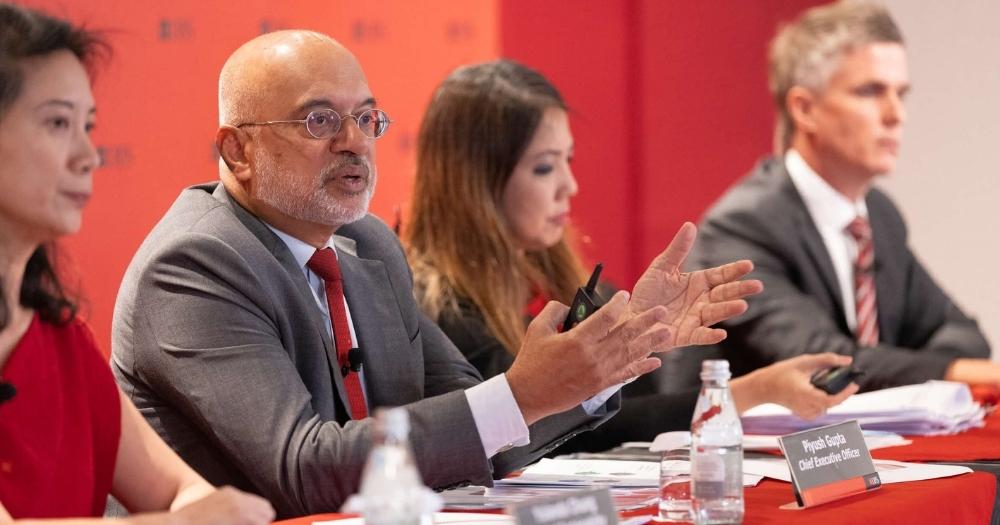Follow us on Telegram for the latest updates: https://t.me/mothershipsg
In a press conference on Tuesday (Sep. 13), DBS Bank (DBS) announced its playbook to achieve a net-zero portfolio by 2050.
Its goal is to reduce its financed emissions, which are emissions generated by client activities financed by DBS.
The targets were released in a report titled "Our Path to Net-Zero - Supporting Asia's Transition to a Low-Carbon Economy".
This announcement comes after DBS became a signatory to the Net-Zero Banking Alliance, a UN-convened group of banks that have committed to aligning their portfolios to net-zero goals.
The bank became a signatory in October 2021, according to the press release.
Nine high emissions sectors singled out
In the report, DBS identified nine sectors on its books that are the most carbon-intensive and will be the focus of its decarbonising efforts:
- Power
- Oil and Gas
- Automative
- Aviation
- Shipping
- Steel
- Real Estate
- Food and Agribusiness
- Chemistry
According to its press release, these sectors represent only 31 per cent of its total loans, but "constitute the vast majority" of their financed emissions.
For these sectors, DBS has set what it called "rigorous and science-based" decarbonisation targets.
28 per cent emissions reduction in oil and gas portfolio by 2030
In its plans, DBS has three different target sets catered to different sectors, according to their suitability.
For the power, automative, aviation and steel sectors, targets are set based on emissions intensity.
For oil and gas, targets are set based on absolute emissions.
In 2020, its oil and gas portfolio produced 38.6 MtCO2e.
It plans to cut that number by 28 per cent by 2030 and 92 per cent by 2050.
 Image via DBS.
Image via DBS.
The bank had previously committed to reducing the number of loans made to coal-based mining and power generation companies by 2039.
Explaining the difference in metric used, Yulanda Chung, Head of Sustainability, Institutional Banking, said that absolute emissions was chosen for oil and gas because "we believe fossil fuels is a sunset industry".
On the other hand, those sectors measured by emissions intensity will continue to play a role in the economy, Chung highlighted.
As such, they will need to be much less carbon-intensive, Chung added.
For shipping and real estate, targets are set based on a methodology called the "Alignment Delta" to cater to the diverse assets that clients might own in these sectors.
For the food and agribusiness and chemistry sectors, there is insufficient data to derive an industry consensus on the net-zero pathway.
Consequently, it is "premature" to set emissions reduction targets for the sectors, the report wrote.
To facilitate future target-setting, DBS has set "data coverage targets" to encourage clients to "improve their GHG emissions reporting".
"Science-based" targets
The bank's commitments represent a sector-specific, target-based approach to decarbonisation.
The commitments are guided by what it calls "glide paths".
 Image via DBS.
Image via DBS.
Explaining this approach, Chung said that DBS looked at modelled scenarios that will allow the world to get to net-zero.
These scenarios are derived from the International Energy Agency and other organisations.
The idea is to bring the bank's portfolio position in line with the targets stated in these modelled scenarios.
As for the real estate and shipping sectors, it uses an alignment delta metric, which basically compares the average across DBS' portfolio against sector-wide benchmarks.
Operationalising the targets
Speaking at the announcement, DBS Chief Executive Officer Piyush Gupta said that these targets provide DBS with a "clear and detailed road map" toward decarbonisation.
The decarbonisation targets will act as the ‘north star’ for our financing activities guiding us to net zero by 2050 through measurable change.
Gupta shared that DBS has worked with consultants and clients to build in the necessary "technology", "apparatus" and "data-sourcing capabilities" so that the bank's progress can be tracked rigorously and reported annually.
The bank is also cognisant of training up its relationship managers, who are the ones on the ground providing advisory services to clients.
"This exercise is not for people sitting in a room or in a vacuum", Gupta pointed out.
However, the bank's ability to meet its targets largely depends on the success of its clients, Tan Su Shan, Group Head, Institutional Banking Group, said.
To accelerate the transition and meet the vast investment needs in the next few decades, we will proactively partner our customers, providing them with financial advisory and transition finance solutions, as we collectively work towards a low-carbon future.
Gupta said that the bank has reached out to thousands of its clients to make sure they are aligned, but the challenge is to make sure they "stay engaged".
To nudge clients in the right direction, Gupta shared that this will come in the form of "incentive structures in terms of better financing" and at times, "disincentive structures".
Top image via DBS
If you like what you read, follow us on Facebook, Instagram, Twitter and Telegram to get the latest updates.
